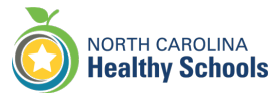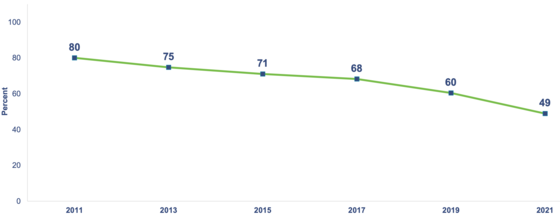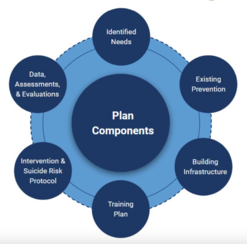
State Board Focuses on Student Mental Health Needs, Efforts to Address Them
Against a backdrop of worrisome data about mental health challenges students in North Carolina schools are now facing, the State Board of Education took steps this month to improve support for students through new programs and potential funding for additional professional staff.
Results from the state’s most recent Youth Risk Behavior Survey – reflecting a representative sample of middle and high school students from 2021 – showed increases in indicators of mental health challenges. Among those:
- 49% of high school students in 2021 said they strongly agreed or agreed that they feel good about themselves, down from 60% in 2019 and 80% in 2011.
- 33% of high school students in 2021 strongly or agreed that they feel alone, up from 31% in 2019 and 19% in 2011.
- 22% of high school students in 2021 seriously considered attempting suicide during the previous 12 months, up from 19% in 2019 and 16% in 2016.
- Gay, lesbian and bisexual students were at greater risk, with 48% having considered suicide
- Female students also were more likely to have considered suicide – 30% in 2021, up from 23% in 2019 and 15% in 2011. Among male students, the proportion remained generally stable at 14%.
Percentage of High School Students Who Strongly Agree or Agree That They Feel Good About Themselves
|

Schools reported that their top health-related concern during the past year has been mental health support for students from counselors and social workers, Ellen Essick, DPI section chief for NC Healthy Schools and specialized instructional support, told the board after presenting the student survey data. Essick said schools ranked safe school environments as their second greatest concern and student health services as third.

The board also heard an update and overview about a joint effort between DPI and the Department of Health and Human Services to prioritize key strategies for supporting the behavioral health needs of North Carolina students.
“What do we need to prioritize, because we know things are not great for too many students,” Dr. Charlene Wong, DHHS assistant secretary for Children and Families, told the board was the effort’s starting point.
The Unified School Behavioral Health Action Plan, as the effort is called, includes strategies to help address the infrastructure, programs, and clinical services necessary to help students and their families recover stronger from the COVID-19 pandemic, enabling every child to be safe and healthy.
Specifically, the plan calls for the expansion of a telehealth pilot program for behavioral health – allowing students to be served from their school, continued funding for a program called Project AWARE/ACTIVATE, a pilot initiative in six school districts to expand student mental health services and forge local partnerships to improve such services and also to provide funding support to local School Health Advisory Councils so that coalitions of school staff, parents and community members can invest in behavioral health resources based on local needs.
Under the unified plan, DPI and DHHS together would seek the $15 million needed to fund those three efforts. The final action plan will be published this spring.
In a related step, the board voted at its meeting this month to include in its budget request to the General Assembly $100 million to fund 1,000 school nurses and social workers for the state’s schools.
“We’re just barely at the tip of the iceberg of what the need is,” said Eric Davis, board chair. “That’s why it’s so important to get these requests in and get them filled and get professionals hired and working.”
|
Districts and Schools Now Able to Track Progress of Graduates
North Carolina school districts and schools will be able track the postsecondary progress of their high school graduates by tapping a nationwide data source of enrollments in nearly all two- and four-year colleges and universities.
The new data tool, presented this month to the State Board of Education, will allow districts and schools to follow the progress of graduates who enroll in postsecondary institutions for eight years after completing high school.
“Individual districts, schools and charters will have access to this data so they can really begin to unpack and understand outcomes the student that they are preparing,” said Jeni Corn, director of research and evaluation in DPI’s Office of Learning Recovery and Acceleration. “Where they’re going, where they’re staying and where they’re graduating.”

By participating in the National Student Clearinghouse, a national non-profit organization that links data about high school graduates to two- and four-year college enrollment data, North Carolina will join 43 other states using the same resource. More than 3,600 colleges and universities participate nationwide, representing about 98% of all institutions of higher education, as well as 20,000 high schools.
The state’s partnership with the National Student Clearinghouse and its StudentTracker tool provides reliable information on high school graduates’ college transition rates that also allow comparisons to similar schools across the country, including those serving low-income and minority students, and also to national averages. This data can help high schools and school districts more accurately gauge the college success of their graduates by answering such key questions such as:
- How many of our high school graduates enroll in college?
- Do they persist and graduate from college?
- How long does it take for them to get their degrees?
- Do they go in or out of state for college?
- Do they attend a two- or four-year school?
- Which colleges do they most commonly attend?
|
StudentTracker for NC
Class of 2014 Postsecondary Enrollment and Progress
 
Each year, every North Carolina public high school and charter school will receive a comprehensive StudentTracker report. This report will provide more than 30 graphs and charts outlining the postsecondary enrollment and achievements of high school graduates.
For the 2022-23 school year, the high school StudentTracker reports will be shared with district and school leaders. A statewide StudentTracker report will be available on the NCDPI website and shared during NCDPI-hosted information sessions and webinars. Aggregated county-level data will be made available through our partnership with myFutureNC through their County Attainment Profiles. DPI also will host webinars this spring for stakeholder groups to explore the StudentTracker reports and see how the data can be used to facilitate best practices and spur innovation.
Corn told the board that the initiative was launched initially with support from the governor’s office from federal COVID-relief funds and that the General Assembly last year included a line item in the state budget for continuing support.
State Superintendent of Public Instruction Catherine Truitt said the data on graduates’ progress provides additional insight for local school leaders.
“Between this data set and the incredible amount of data that the Office of Learning Recovery has provided districts through the Lost Instructional Time Report, I think it’s safe to say our local school leaders have an unprecedented amount of data about their students,” Truitt said. In particular, she said, the StudentTracker information can provide valuable information about those students who enrolled in college but dropped out or never graduated.
She noted that a similar data report in recent years for myFutureNC, an effort aimed at increasing the number of North Carolinians with a postsecondary degree or credential, showed that only about 22% to 23% of high school graduates had earned a four-year degree by the age of 24.

Board Previews Legislative, Policy Changes Needed if Licensure Plan Wins Approval
As the State Board and State Superintendent of Public Instruction Catherine Truitt continue to press for an overhaul of North Carolina’s system of licensing and compensating teachers, the board reviewed a long list of changes to state laws and board policies needed under a pilot of the new plan.
Truitt and the board hope to win approval from the General Assembly to launch the plan on a pilot basis beginning this fall in several school districts.
Allison Schafer, general counsel to the board and the Department of Public Instruction, outlined the various legal steps that would be needed to revise the way teachers are licensed and compensated in the pilot districts as proposed in the new plan, called the North Carolina Pathways to Excellence for Teaching Professionals.
Among the changes that Schafer said would be needed are several exemptions from current legislation and policies for the potential pilot districts to depart from the state’s established rules governing licensure and compensation. These would include:
- Exemption from specific current statutory requirements that districts must employ teachers licensed under current law.
- Possible exemption from the current licensing requirement that teachers must pass a licensure exam.
- New authorization from the General Assembly allowing the State Board to create new categories of licensure, such as an apprentice license.
- Possible exemption from current universal pay schedules in place for teachers.
- The legislature would also likely need to authorize the allocation of sufficient additional funds to the extent needed to pay the different salaries and other additional costs under the pilot program.
Board Chair Eric Davis said the board hopes to receive recommendations in March from the Professional Educator Preparation and Standards Commission (PEPSC) on the pilot proposal so that the needed changes to legislation can be negotiated with the General Assembly.
“If we can move fast enough – to launch the pilots in the fall,” Davis said. “That’s pretty aggressive.” He said that it was likely that if the pilot approach is allowed to move forward, those districts would follow the Pathways model for a minimum of two years.
“That would enough of the process to work to generate results to form conclusions about how the implement the program more broadly,” he said. “We’re trying to move as aggressively as we can because our students and teachers sorely need these improvements and benefits. But it’s complex, so we need to be thoughtful about how fast to generate the changes.”
|

Alamance-Burlington Educator Wins National CTE Award
The State Board of Education at its January meeting recognized Alamance-Burlington School System educator Lindsey Criss, who won national recognition from the Association for Career and Technical Education as its 2023 ACTE Teacher Educator of the Year.
This award recognizes teacher educators who have demonstrated innovation in teacher education, leadership in improving CTE, and commitment to preparing teachers to deliver high quality CTE programs.
Criss serves as the CTE Curriculum and Instructional Management Coordinator for the Alamance-Burlington district, providing relevant, programmatic training for CTE teachers aligned to the district's professional development initiatives.
|
|